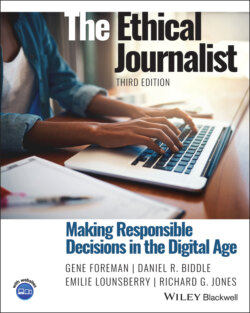Читать книгу The Ethical Journalist - Gene Foreman - Страница 69
Explanations for the Hostility
ОглавлениеAlthough public hostility to the news media has been well documented, the reasons for the hostility have not been. Thus the question is open to speculation.
Roy Peter Clark of the Poynter Institute has noted a correlation between the low credibility ratings and relentless attacks on the news media. He says the attacks are coming from many directions, with a persuasive cumulative effect on “a public that has been conditioned to hate us.” In a column in January 2008, Clark mentioned politicians under pressure who “try to kill the media messenger”; radio talk shows with an agenda of wanting to destroy the credibility of the mainstream press; and the negative portrayal of journalists in films and television dramas. Clark concluded: “The public bias against the press is a more serious problem for American democracy than the bias (real or perceived) of the press itself.”14 And Clark made this point eight years before Donald Trump was elected president in a campaign that relied heavily on denunciation of the news media.
Over the longer term, suspicion of the news media has been fueled by the media’s dual nature – most news organizations have to make a profit at the same time that they fulfill their quasi‐civic function of informing the community. It is easy for cynics to ask: Are they reporting this story because it is news the public needs, or are they just trying to attract web traffic, raise broadcast ratings, or sell papers?
Another chronic problem, discussed by the authors of Doing Ethics in Journalism, is the way journalists explain their newsgathering decisions to the public. Rather than reflexively citing their legal right to publish the information, they should be emphasizing their moral obligation to report the news, the authors wrote, adding, “There is a tendency by journalists to wrongly assume the public understands the rationale behind First Amendment protections.”15
William F. Woo, a newspaper editor and later a Stanford University professor, wrote that journalists had to take some of the blame for the public’s lack of sympathy with the First Amendment. In Letters From the Editor, he wrote:
Many of us seem to think that the amendment was written for the press, rather than for the people, and that it confers upon us special privileges or rights that are not given to others. … There is almost no phrase used by journalists that I dislike more than “the public’s right to know,” for it so often justifies not courage and independence but excess, intrusion and abuse.16
Sometimes, the public misunderstands journalism’s mission, which quite likely was a factor in the reaction to the Grand Forks Herald’s outing of Joan Kroc as the Angel. In another common misunderstanding of journalism’s purpose, some people watching televised interviews and news conferences perceive that journalists are being discourteous when they ask tough but appropriate questions of public officials.
A cause of tension, for many newspapers at least, is that the editorial pages express opinions about the people and events covered on the news pages. Even though the news and editorials are written by separate staffs (or at least they should be), readers often conclude that a paper’s editorial position influences its news coverage. In addition, some people may refuse to buy a paper whose editorials they disagree with. Unquestionably, these are downsides, but journalists generally think it is important that the newspaper offer informed opinion on issues in the news and stand up for what its editorial board thinks is sound public policy, especially when the issues have a moral dimension.
